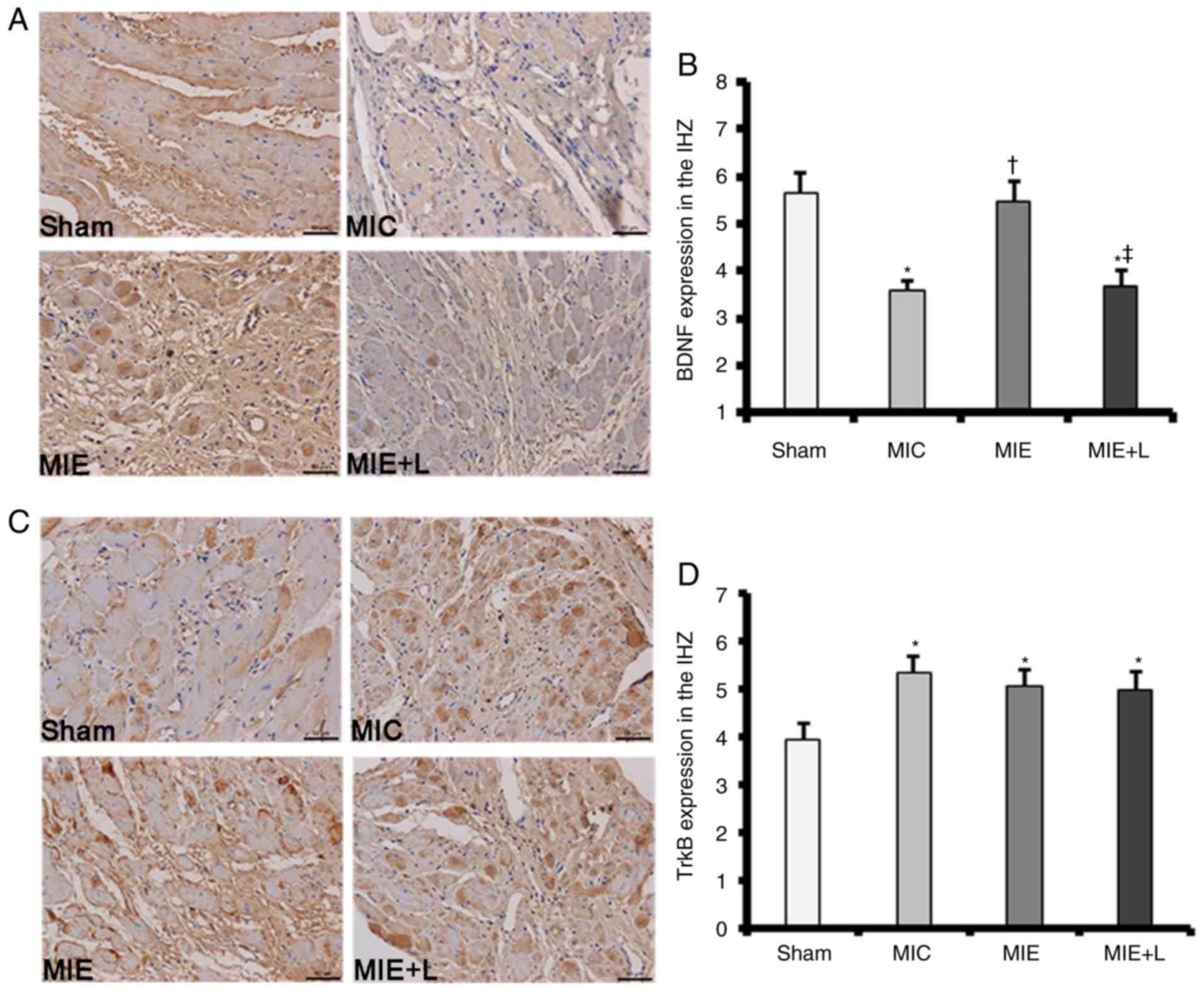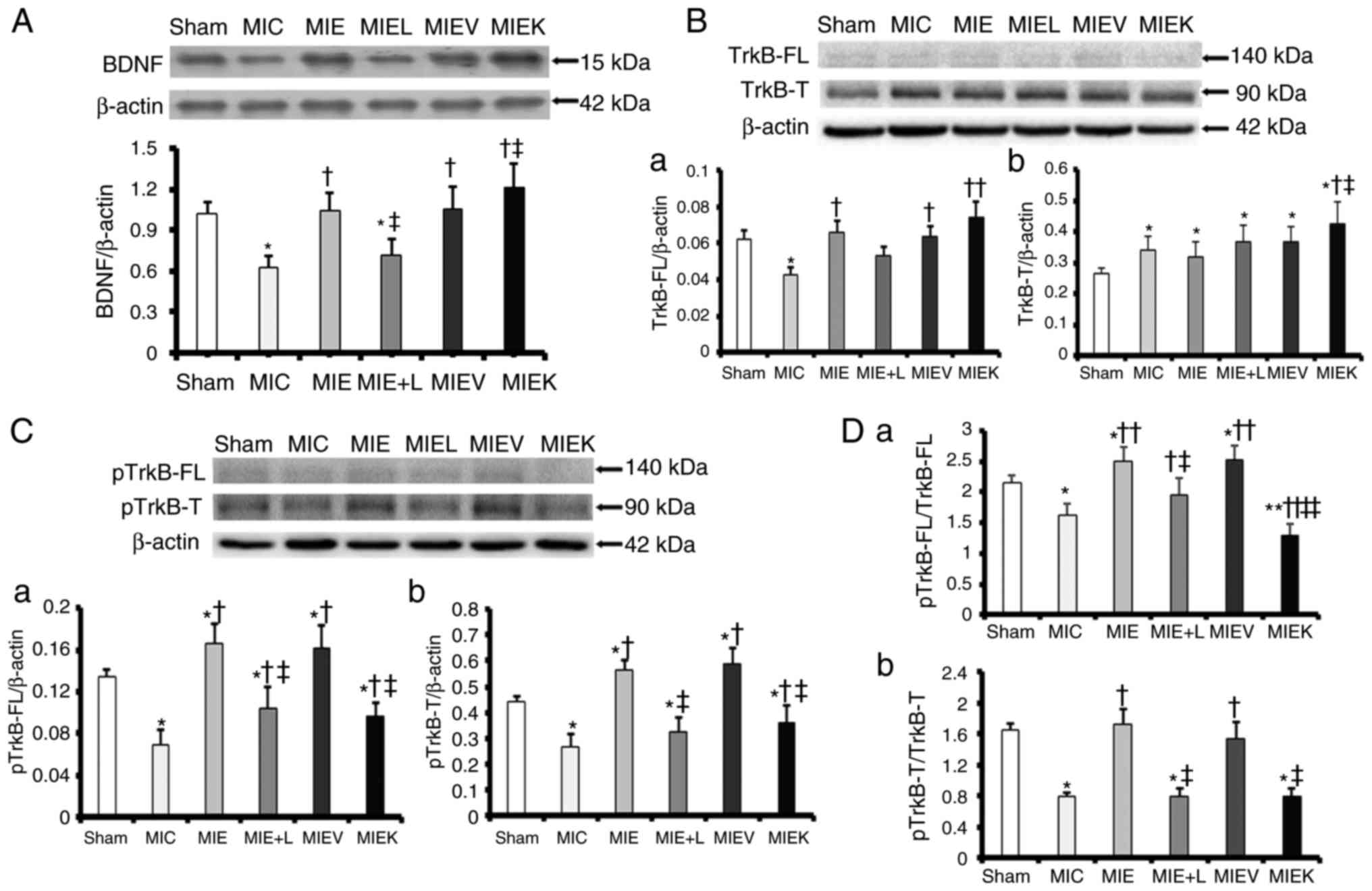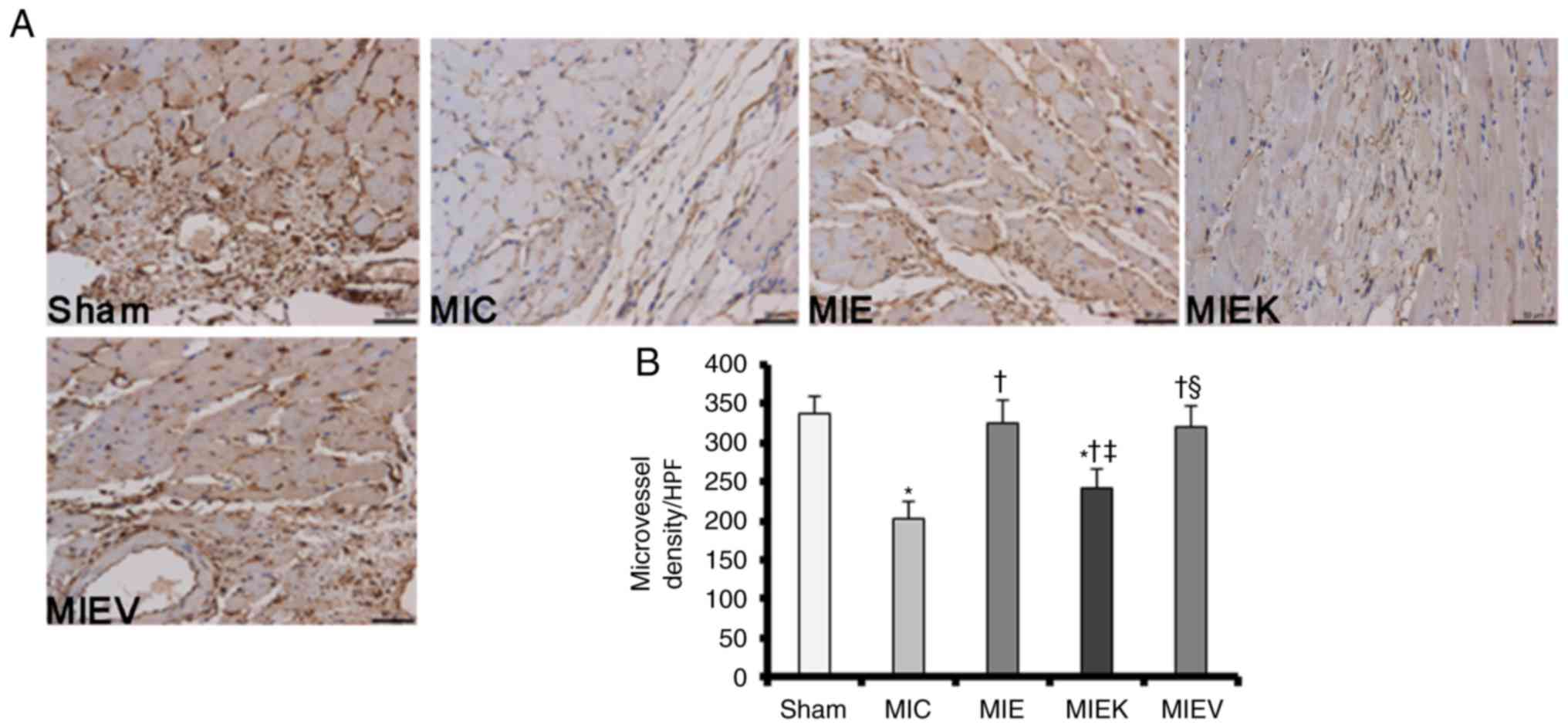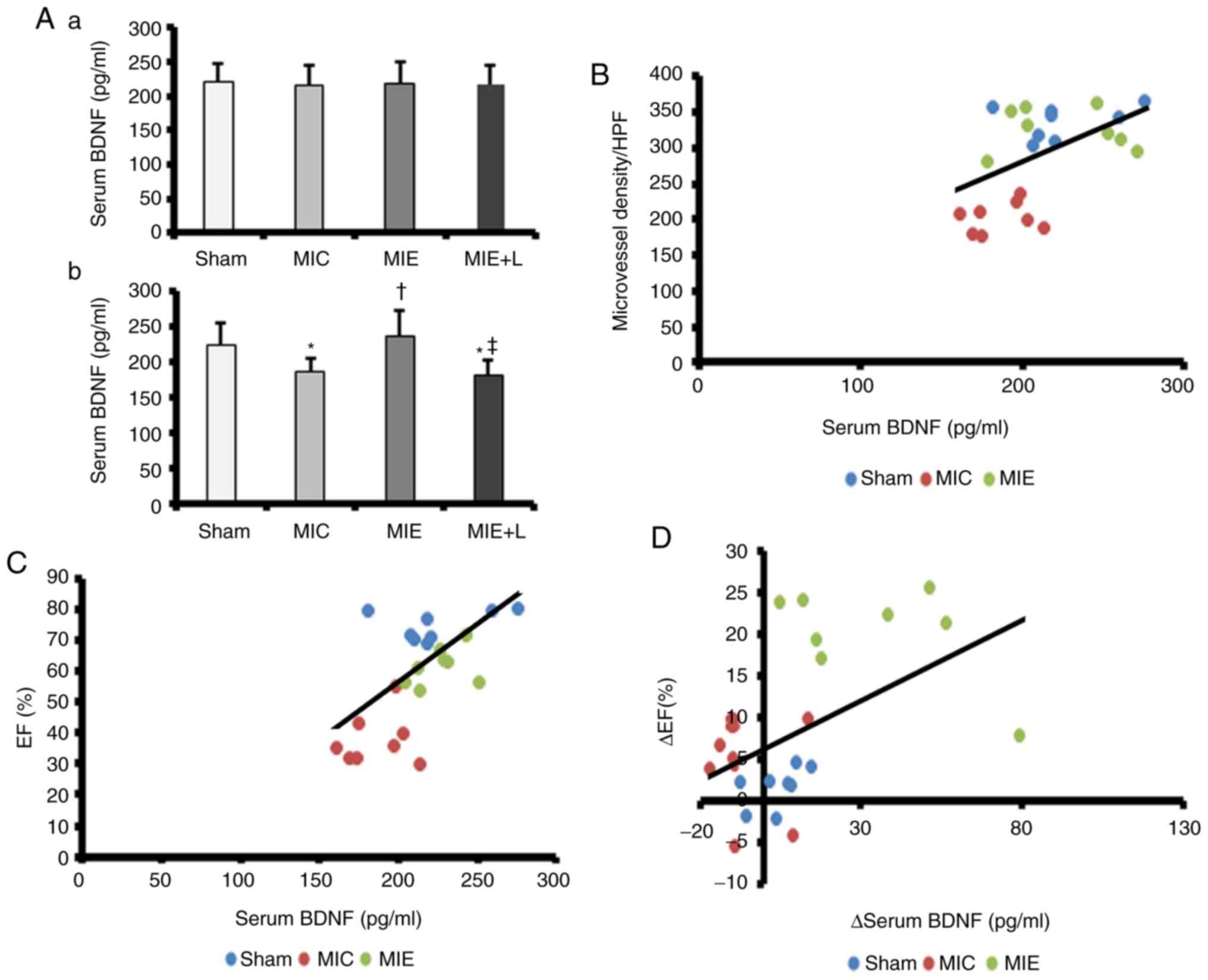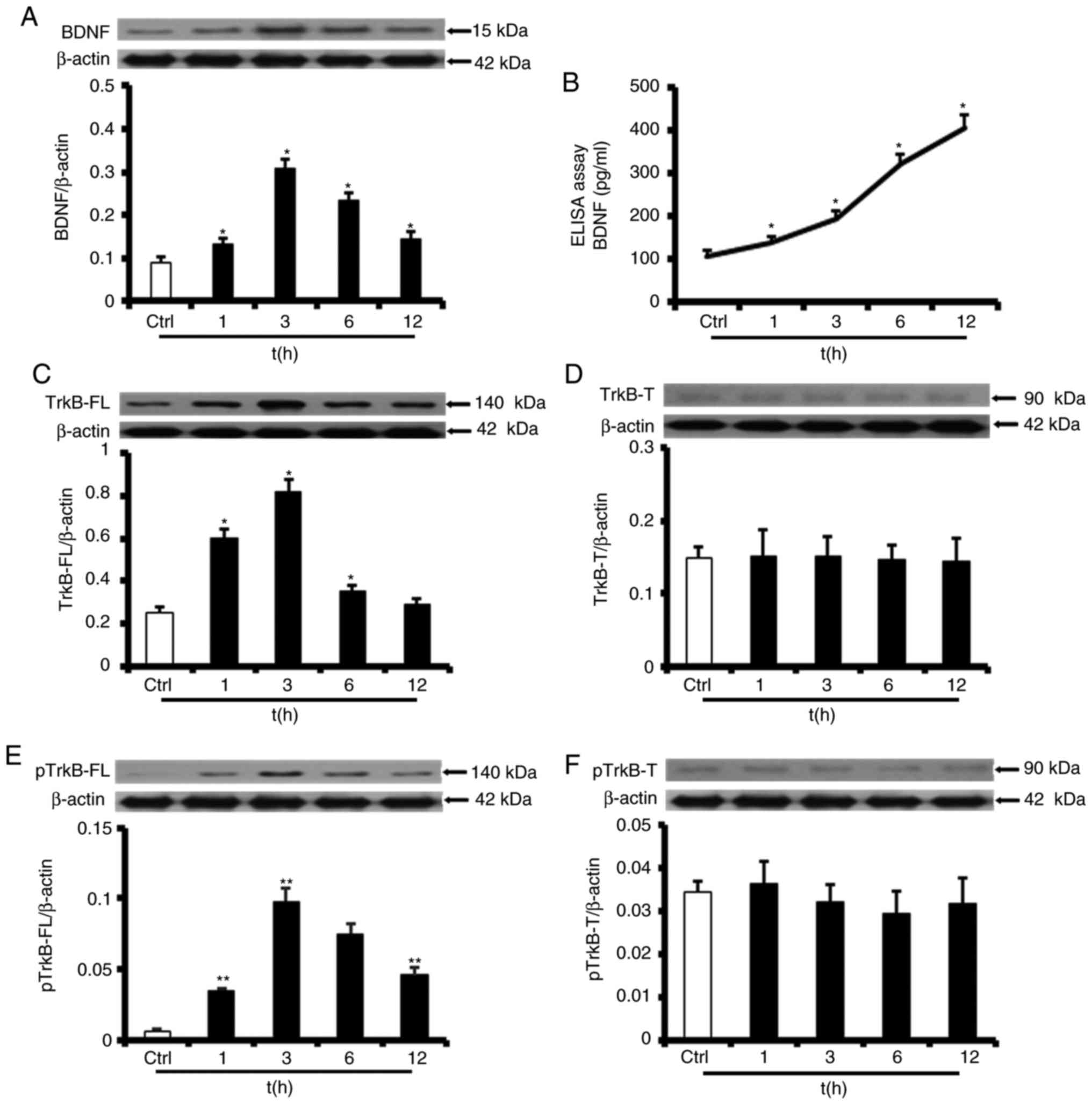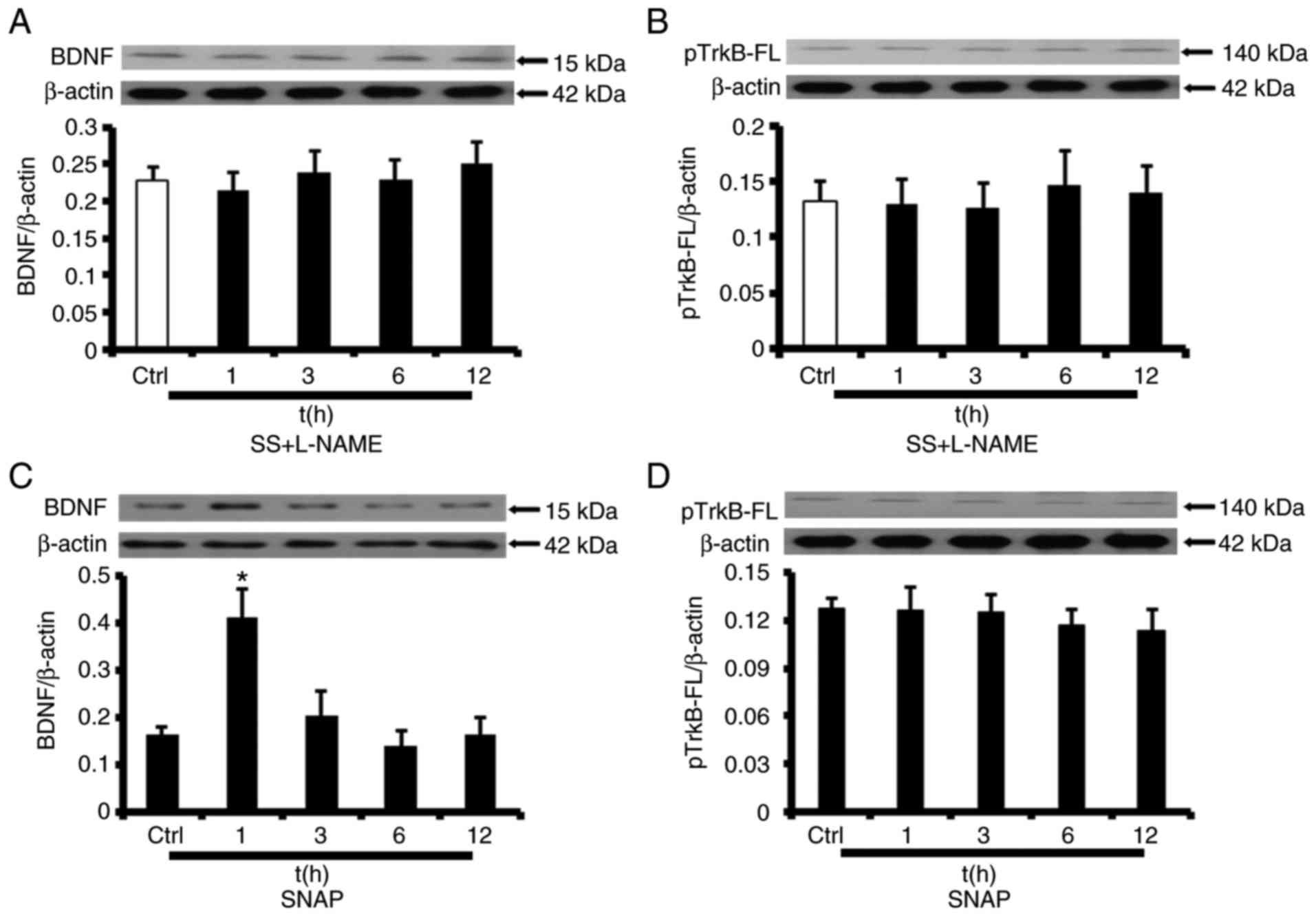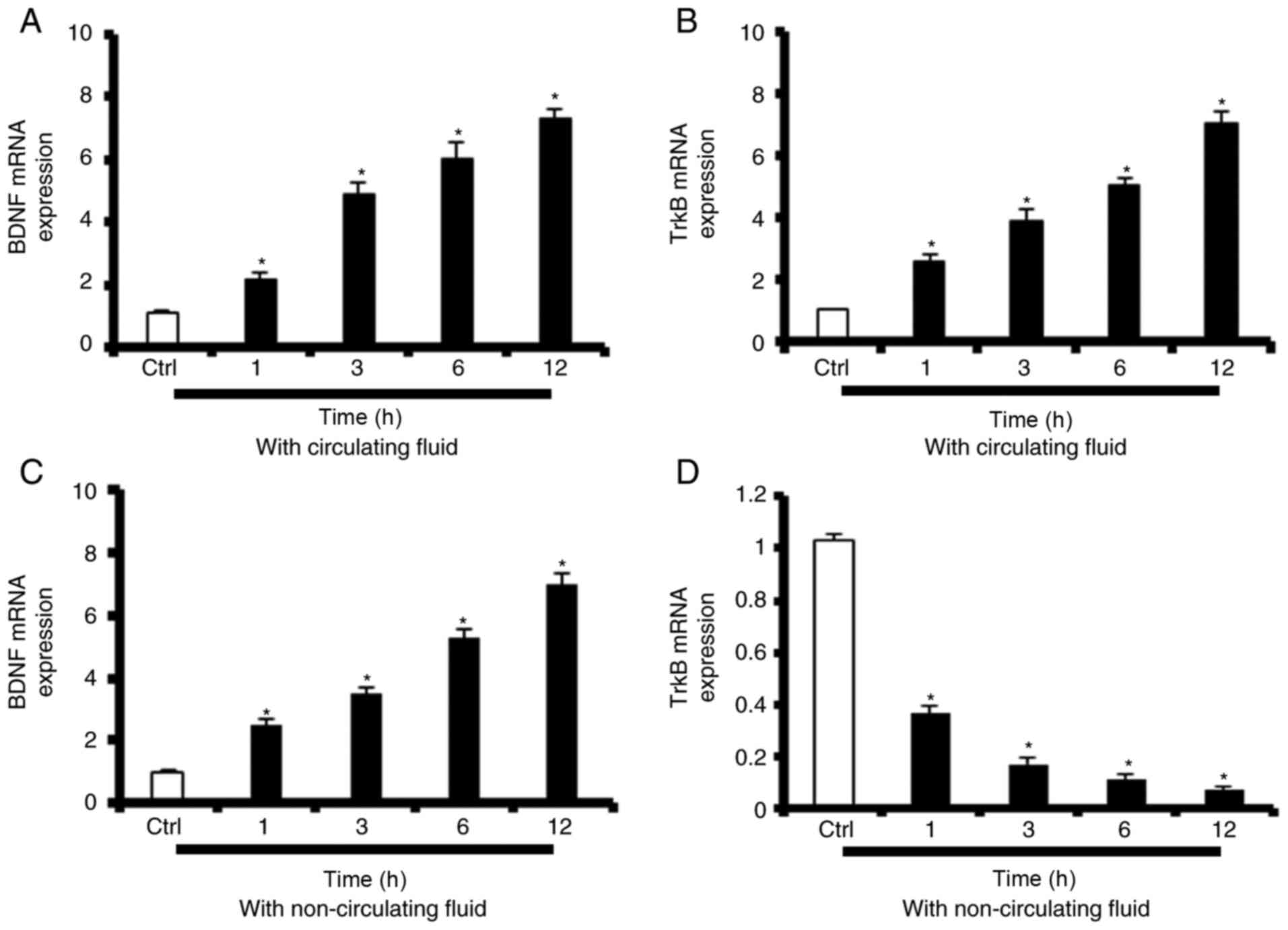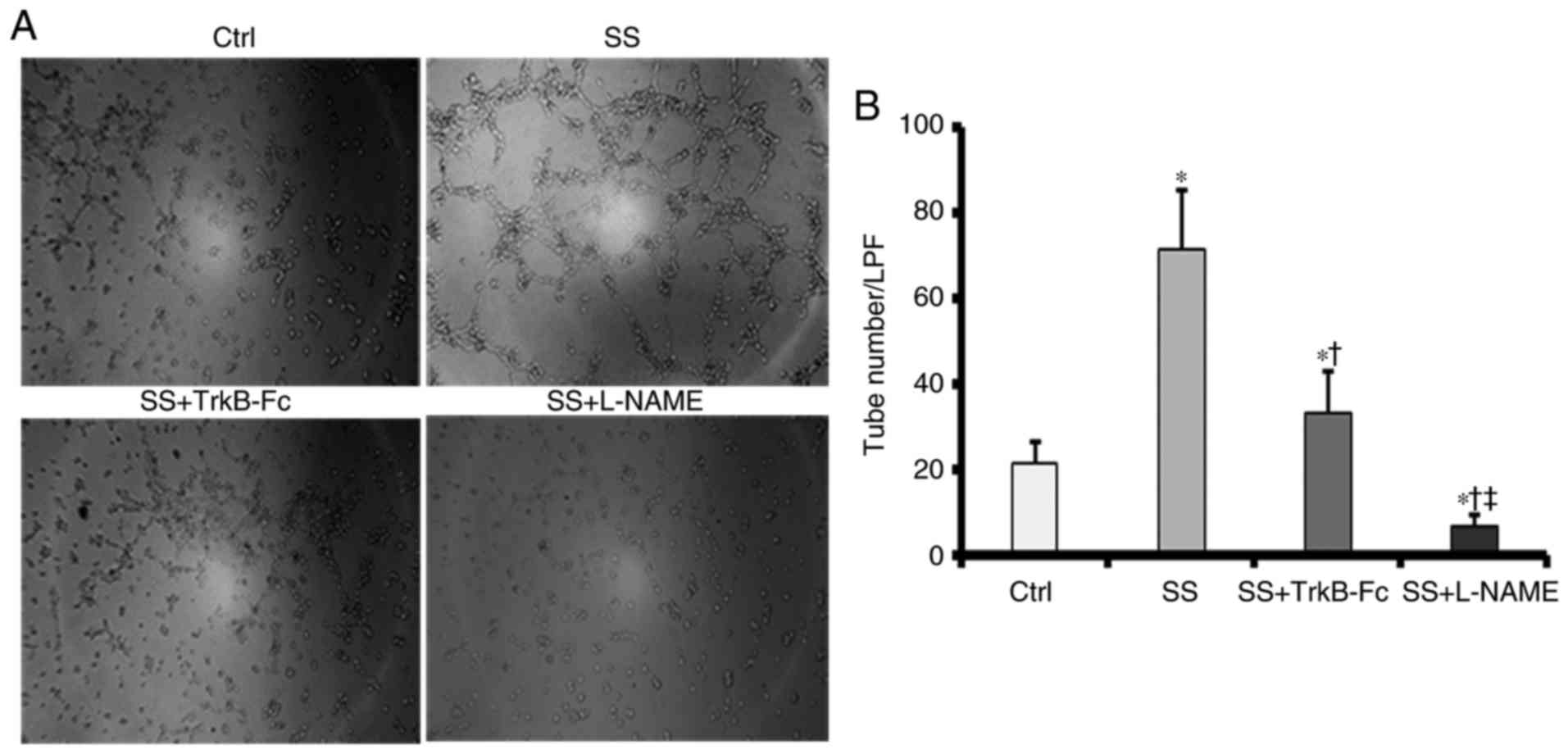|
1
|
Barbacid M: Neurotrophic factors and their
receptors. Curr Opin Cell Biol. 7:148–155. 1995. View Article : Google Scholar : PubMed/NCBI
|
|
2
|
Chao MV: Neurotrophins and their
receptors: A convergence point for many signalling pathways. Nat
Rev Neurosci. 4:299–309. 2003. View
Article : Google Scholar : PubMed/NCBI
|
|
3
|
Monteggia LM, Barrot M, Powell CM, Berton
O, Galanis V, Gemelli T, Meuth S, Nagy A, Greene RW and Nestler EJ:
Essential role of brain-derived neurotrophic factor in adult
hippocampal function. Proc Natl Acad Sci USA. 101:10827–10832.
2004. View Article : Google Scholar : PubMed/NCBI
|
|
4
|
Okada S, Yokoyama M, Toko H, Tateno K,
Moriya J, Shimizu I, Nojima A, Ito T, Yoshida Y, Kobayashi Y, et
al: Brain-derived neurotrophic factor protects against cardiac
dysfunction after myocardial infarction via a central nervous
system-mediated pathway. Arterioscler Thromb Vasc Biol.
32:1902–1909. 2012. View Article : Google Scholar : PubMed/NCBI
|
|
5
|
Kermani P, Rafii D, Jin DK, Whitlock P,
Schaffer W, Chiang A, Vincent L, Friedrich M, Shido K, Hackett NR,
et al: Neurotrophins promote revascularization by local recruitment
of TrkB+ endothelial cells and systemic mobilization of
hematopoietic progenitors. J Clin Invest. 115:653–663. 2005.
View Article : Google Scholar : PubMed/NCBI
|
|
6
|
Donovan MJ, Lin MI, Wiegn P, Ringstedt T,
Kraemer R, Hahn R, Wang S, Ibañez CF, Rafii S and Hempstead BL:
Brain derived neurotrophic factor is an endothelial cell survival
factor required for intramyocardial vessel stabilization.
Development. 127:4531–4540. 2000.PubMed/NCBI
|
|
7
|
Cao L, Zhang L, Chen S, Yuan Z, Liu S,
Shen X, Zheng X, Qi X, Lee KK, Chan JY and Cai D: BDNF-mediated
migration of cardiac microvascular endothelial cells is impaired
during ageing. J Cell Mol Med. 16:3105–3115. 2012. View Article : Google Scholar : PubMed/NCBI
|
|
8
|
Liu Y, Sun L, Huan Y, Zhao H and Deng J:
Application of bFGF and BDNF to improve angiogenesis and cardiac
function. J Surg Res. 136:85–91. 2006. View Article : Google Scholar : PubMed/NCBI
|
|
9
|
Feng N, Huke S, Zhu G, Tocchetti CG, Shi
S, Aiba T, Kaludercic N, Hoover DB, Beck SE, Mankowski JL, et al:
Constitutive BDNF/TrkB signaling is required for normal cardiac
contraction and relaxation. Proc Natl Acad Sci USA. 112:1880–1885.
2015. View Article : Google Scholar : PubMed/NCBI
|
|
10
|
Fulgenzi G, Tomassoni-Ardori F, Babini L,
Becker J, Barrick C, Puverel S and Tessarollo L: BDNF modulates
heart contraction force and long-term homeostasis through truncated
TrkB. T1 receptor activation J Cell Biol. 210:1003–1012. 2015.
|
|
11
|
Fukushima A, Kinugawa S, Homma T, Masaki
Y, Furihata T, Yokota T, Matsushima S, Abe T, Suga T, Takada S, et
al: Decreased serum brain-derived neurotrophic factor levels are
correlated with exercise intolerance in patients with heart
failure. Int J Cardiol. 168:e142–e144. 2013. View Article : Google Scholar : PubMed/NCBI
|
|
12
|
Swardfager W, Herrmann N, Marzolini S,
Saleem M, Shammi P, Oh PI, Albert PR, Daigle M, Kiss A and Lanctôt
KL: Brain derived neurotrophic factor, cardiopulmonary fitness and
cognition in patients with coronary artery disease. Brain Behav
Immun. 25:1264–1271. 2011. View Article : Google Scholar : PubMed/NCBI
|
|
13
|
Circulating brain-derived neurotrophic
factor concentrations and the risk of cardiovascular disease in the
community. J Am Heart Assoc. 5:e0020982016.PubMed/NCBI
|
|
14
|
Möbius-Winkler S, Uhlemann M, Adams V,
Sandri M, Erbs S, Lenk K, Mangner N, Mueller U, Adam J, Grunze M,
et al: Coronary collateral growth induced by physical exercise:
Results of the impact of intensive exercise training on coronary
collateral circulation in patients with stable coronary artery
disease (EXCITE) trial. Circulation. 133:1438–1448. 2016.
View Article : Google Scholar : PubMed/NCBI
|
|
15
|
Leosco D, Rengo G, Iaccarino G, Golino L,
Marchese M, Fortunato F, Zincarelli C, Sanzari E, Ciccarelli M,
Galasso G, et al: Exercise promotes angiogenesis and improves
beta-adrenergic receptor signalling in the post-ischaemic failing
rat heart. Cardiovasc Res. 78:385–394. 2008. View Article : Google Scholar
|
|
16
|
Tang XY, Hong HS, Chen LL, Lin XH, Lin JH
and Lin Z: Effects of exercise of different intensities on the
angiogenesis, infarct healing, and function of the left ventricle
in postmyocardial infarction rats. Coron Artery Dis. 22:497–506.
2011. View Article : Google Scholar : PubMed/NCBI
|
|
17
|
Tinken TM, Thijssen DH, Hopkins N, Dawson
EA, Cable NT and Green DJ: Shear stress mediates endothelial
adaptations to exercise training in humans. Hypertension.
55:312–318. 2010. View Article : Google Scholar : PubMed/NCBI
|
|
18
|
Duncker DJ and Bache RJ: Regulation of
coronary blood flow during exercise. Physiol Rev. 88:1009–1086.
2008. View Article : Google Scholar : PubMed/NCBI
|
|
19
|
Marsh SA and Coombes JS: Exercise and the
endothelial cell. Int J Cardiol. 99:165–169. 2005. View Article : Google Scholar : PubMed/NCBI
|
|
20
|
Zoladz JA and Pilc A: The effect of
physical activity on the brain derived neurotrophic factor: From
animal to human studies. J Physiol Pharmacol. 61:533–541. 2010.
|
|
21
|
Lee HW, Ahmad M, Wang HW and Leenen FH:
Effects of exercise training on brain-derived neurotrophic factor
in skeletal muscle and heart of rats post myocardial infarction.
Exp Physiol. 102:314–328. 2017. View Article : Google Scholar : PubMed/NCBI
|
|
22
|
Prigent-Tessier A, Quirié A, Maguin-Gaté
K, Szostak J, Mossiat C, Nappey M, Devaux S, Marie C and Demougeot
C: Physical training and hypertension have opposite effects on
endo-thelial brain-derived neurotrophic factor expression.
Cardiovasc Res. 100:374–382. 2013. View Article : Google Scholar : PubMed/NCBI
|
|
23
|
Nakahashi T, Fujimura H, Altar CA, Li J,
Kambayashi J, Tandon NN and Sun B: Vascular endothelial cells
synthesize and secrete brain-derived neurotrophic factor. FEBS
Lett. 470:113–117. 2000. View Article : Google Scholar : PubMed/NCBI
|
|
24
|
Hiraoka Y, Kishimoto C, Takada H, Nakamura
M, Kurokawa M, Ochiai H and Shiraki K: Nitric oxide and murine
coxsackievirus B3 myocarditis: Aggravation of myocarditis by
inhibition of nitric oxide synthase. J Am Coll Cardiol.
28:1610–1615. 1996. View Article : Google Scholar : PubMed/NCBI
|
|
25
|
Jiménez-Maldonado A, de Álvarez-Buylla ER,
Montero S, Melnikov V, Castro-Rodríguez E, Gamboa-Domínguez A,
Rodríguez-Hernández A, Lemus M and Murguía JM: Chronic exercise
increases plasma brain-derived neurotrophic factor levels,
pancreatic islet size, and insulin tolerance in a TrkB-dependent
manner. PLoS One. 9:e1151772014. View Article : Google Scholar : PubMed/NCBI
|
|
26
|
Livak KJ and Schmittgen TD: Analysis of
relative gene expression data using real-time quantitative PCR and
the 2(−Delta Delta C(T)) method. Method. 25:402–408. 2001.
View Article : Google Scholar
|
|
27
|
Siemerink MJ, Klaassen I, Vogels IM,
Griffioen AW, Van Noorden CJ and Schlingemann RO: CD34 marks
angiogenic tip cells in human vascular endothelial cell cultures.
Angiogenesis. 15:151–163. 2012. View Article : Google Scholar : PubMed/NCBI
|
|
28
|
Frisén J, Verge VM, Fried K, Risling M,
Persson H, Trotter J, Hökfelt T and Lindholm D: Characterization of
glial trkB receptors: Differential response to injury in the
central and peripheral nervous systems. Proc Natl Acad Sci USA.
90:4971–4975. 1993. View Article : Google Scholar : PubMed/NCBI
|
|
29
|
Suh GY, Les AS, Tenforde AS, Shadden SC,
Spilker RL, Yeung JJ, Cheng CP, Herfkens RJ, Dalman RL and Taylor
CA: Hemodynamic changes quantified in abdominal aortic aneurysms
with increasing exercise intensity using mr exercise imaging and
image-based computational fluid dynamics. Ann Biomed Eng.
39:2186–2202. 2011. View Article : Google Scholar : PubMed/NCBI
|
|
30
|
Rodriguez I and Gonzalez M: Physiological
mechanisms of vascular response induced by shear stress and effect
of exercise in systemic and placental circulation. Front Pharmacol.
5:2092014.PubMed/NCBI
|
|
31
|
Wragg JW, Durant S, McGettrick HM, Sample
KM, Egginton S and Bicknell R: Shear stress regulated gene
expression and angiogenesis in vascular endothelium.
Microcirculation. 21:290–300. 2014. View Article : Google Scholar : PubMed/NCBI
|
|
32
|
Papaioannou TG and Stefanadis C: Vascular
wall shear stress: Basic principles and methods. Hellenic J
Cardiol. 46:9–15. 2005.PubMed/NCBI
|
|
33
|
Barnes JM, Nauseef JT and Henry MD:
Resistance to fluid shear stress is a conserved biophysical
property of malignant cells. PLoS One. 7:e509732012. View Article : Google Scholar : PubMed/NCBI
|
|
34
|
Galie PA, Nguyen DH, Choi CK, Cohen DM,
Janmey PA and Chen CS: Fluid shear stress threshold regulates
angiogenic sprouting. Proc Natl Acad Sci USA. 111:7968–7973. 2014.
View Article : Google Scholar : PubMed/NCBI
|
|
35
|
Ueda A, Koga M, Ikeda M, Kudo S and
Tanishita K: Effect of shear stress on microvessel network
formation of endothelial cells with in vitro three-dimensional
model. Am J Physiol Heart Circ Physiol. 287:H994–H1002. 2004.
View Article : Google Scholar : PubMed/NCBI
|
|
36
|
Guo W, Ji Y, Wang S, Sun Y and Lu B:
Neuronal activity alters BDNF-TrkB signaling kinetics and
downstream functions. J Cell Sci. 127:2249–2260. 2014. View Article : Google Scholar : PubMed/NCBI
|
|
37
|
Ji Y, Lu Y, Yang F, Shen W, Tang TT, Feng
L, Duan S and Lu B: Acute and gradual increases in BDNF
concentration elicit distinct signaling and functions in neurons.
Nat Neurosci. 13:302–309. 2010. View Article : Google Scholar : PubMed/NCBI
|
|
38
|
Ando J, Ohtsuka A, Korenaga R and Kamiya
A: Effect of extracellular ATP level on flow-induced
Ca++ response in cultured vascular endothelial cells.
Biochem Biophys Res Commun. 179:1192–1199. 1991. View Article : Google Scholar : PubMed/NCBI
|
|
39
|
Yamamoto K, Korenaga R, Kamiya A and Ando
J: Fluid shear stress activates Ca(2+) influx into human
endothelial cells via P2X4 purinoceptors. Circ Res. 87:385–391.
2000. View Article : Google Scholar : PubMed/NCBI
|
|
40
|
Jin H, Chen Y, Wang B, Zhu Y, Chen L, Han
X, Ma G and Liu N: Association between brain-derived neurotrophic
factor and von Willebrand factor levels in patients with stable
coronary artery disease. BMC Cardiovasc Disord. 18:232018.
View Article : Google Scholar : PubMed/NCBI
|
|
41
|
Calvert JW: Cardioprotective effects of
nitrite during exercise. Cardiovasc Res. 89:499–506. 2011.
View Article : Google Scholar :
|
|
42
|
Cui X, Chopp M, Zacharek A, Ning R, Ding
X, Roberts C and Chen J: Endothelial nitric oxide synthase
regulates white matter changes via the BDNF/TrkB pathway after
stroke in mice. PLoS One. 8:e803582013. View Article : Google Scholar : PubMed/NCBI
|
|
43
|
Li ST, Pan J, Hua XM, Liu H, Shen S, Liu
JF, Li B, Tao BB, Ge XL, Wang XH, et al: Endothelial nitric oxide
synthase protects neurons against ischemic injury through
regulation of brain-derived neurotrophic factor expression. CNS
Neurosci Ther. 20:154–164. 2014. View Article : Google Scholar : PubMed/NCBI
|
|
44
|
Kolluru GK, Sinha S, Majumder S, Muley A,
Siamwala JH, Gupta R and Chatterjee S: Shear stress promotes nitric
oxide production in endothelial cells by sub-cellular
delocalization of eNOS: A basis for shear stress mediated
angiogenesis. Nitric Oxide. 22:304–315. 2010. View Article : Google Scholar : PubMed/NCBI
|



